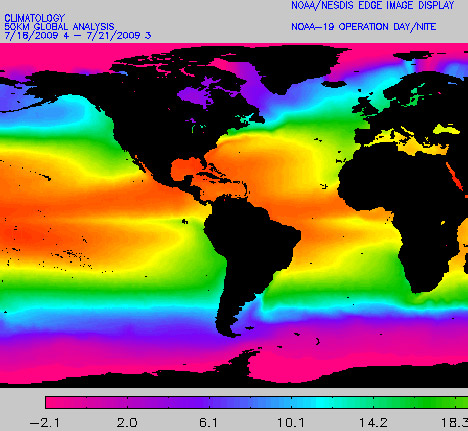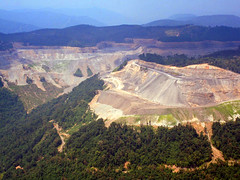Congress will have a lot on its plate when it returns to session in approximately two weeks: health care, war/torture, food safety and of course climate change. Indeed, it’s beginning to look like, once again, the hopes of significant international effort to redress global warming are—arguably with good reason—landing square on the shoulders of Uncle Sam. As reported in many places yesterday, the Indian government has all but asked to be shamed into participating, and for developed nations to “call it’s bluff.” In a similar vein, and also making the rounds on Wednesday, was a statement from the Swedish minister of environment suggesting that: If the U.S. leads, China will follow. Alas, the fate of Waxman-Markley is still unclear, but at least this time Congress seems to be working towards the goal before international negotiations begin rather than against it. Perhaps you’d like to give your elected officials an encouraging nudge?
Tag Archives: Climate
Applied Chemistry
This month’s Sierra magazine includes a blurb about some of the lesser known impacts of fossil fuel use & global warming.
Half of the carbon dioxide we’ve put into the atmosphere since 1800 has been absorbed by the world’s oceans, increasing acidity by 30% and changing seawater to carbonic acid. In terms of pH (lower numbers equate to higher acidity), that means a drop of 0.1 from preindustrial levels [8.1] to today’s 8. If trends continue, ocean pH will be 7.7 by the end of the century. At 7.8, however, shell formation ceases. Barnacles, sea snails, and corals will decline precipitously.
In fact, the Caribbean is already impacted, as are sensitive Alaskan waters.
For those of you whom may have forgotten your high school chemistry: Like the Richter scale, pH is logarithmic and each whole number actually corresponds to a ten-fold change in the measured value. Thus the drop from a pH of 8.1 to 8 amounts to the cited 30% increase in acidity, or more specifically a 26% decline in alkalinity.
Carbonic acid is the product of carbon dioxide dissolved in water and it is present in beverages from seltzer to soda pop. Although it is a very mild acid, large quantities of can take their toll, and carbonic acid’s presence in ground water is responsible for the formation of limestone caves. Limestone is of course a sedimentary rock formed from the skeletons and shells of ancient sea-life…
It is interesting to note that since 1976 the EPA has regulated alteration of of pH as a pollutant, permitting variance of 0.2 from normal. This standard has undergone some scrutiny recently, and is likely too lax.
Youth take the lead on climate change and planet stewardship
 Today was a sad day for the environment, with reports released on the safety of our rivers and oceans being at stake. It is hard to imagine that every river in the US has fish contaminated with mercury or that the plastic bags circulating in the Pacific Ocean in an area twice the size of Texas is now being found to be breaking down into a toxic soup of bisphenol-a. More than ever, we need a movement to rise up and protect this fragile blue orb that supports life as we know it.
Today was a sad day for the environment, with reports released on the safety of our rivers and oceans being at stake. It is hard to imagine that every river in the US has fish contaminated with mercury or that the plastic bags circulating in the Pacific Ocean in an area twice the size of Texas is now being found to be breaking down into a toxic soup of bisphenol-a. More than ever, we need a movement to rise up and protect this fragile blue orb that supports life as we know it.
What gives me hope, is an article I came across today, that the seeding of such a movement is underway. Over seven hundred youth from across the globe have gathered in Daejeon, Republic of Korea, to call on leaders to address Climate Change at Copenhagen in December and involve youth in environmental decisions. Young people comprise of 3 billion of the global population and will be faced by the growing environmental challenges plaguing the planet. They asked that environmental education be included in their curriculum and that global citizens take real steps to reduce their impacts on the planet like using public transportation and purchasing environmentally friendly products.
One of the most poignant statements from a youth delegate from the Netherlands, “We are the generation of tomorrow. The decisions that are made today will define our future and the world we have to live in. So we young people of the world urge governments to commit to a strong post-Kyoto climate regime. It is our lives we are talking about.” Will the public and political leadership heed their call?
Ocean temperature breaks June heat record & other canaries in the coal mine…
 While climate change skeptics continue to derail needed climate policy and deepen the public’s confusion on accepted science, the planet is exhibiting more acute global warming symptoms. Recent observations are indicating that climate change is occurring at a faster pace and of a greater magnitude than predicted by IPCC models. Our Oceans are showing a decreased ability to absorb our excess carbon, leading to ocean acidification– reducing the ability of many marine organisms to build their shells and skeletal structure.
While climate change skeptics continue to derail needed climate policy and deepen the public’s confusion on accepted science, the planet is exhibiting more acute global warming symptoms. Recent observations are indicating that climate change is occurring at a faster pace and of a greater magnitude than predicted by IPCC models. Our Oceans are showing a decreased ability to absorb our excess carbon, leading to ocean acidification– reducing the ability of many marine organisms to build their shells and skeletal structure.
The Ocean which covers 70 percent of our planet, just broke a record last month for the warmest temperature on record and combined with land temperatures it was second to 2005’s all time high. Run away global warming is a real concern with the potential for accelerated ice melt and rising sea levels, which are also exceeding IPCC predictions in the Latest Climate Science publication.
Summer has yet to run its course and it is likely that other potential record breaking climate change news will occur. How much more data is needed before we can leave the debate behind and step up our collective action on climate change? In a recent Global poll, Americans ranked government action on climate change as the lowest priority compared to any other country. We have a long way to go…
The meat and climate debate

In a recent Washington Post article, the climate change debate was brought to a new level: what about meat? Politicians and environmental activists alike argue over cap-and-trade, mitigation, adaptation, and hybrid cars, but what about the energy used and green house gases (GHG) emitted from intensive livestock practices (factory farms) across the nation, and around the world? The Post article cited a 2006 United Nations report stating 18 percent of global GHG emissions comes from livestock. Never mind the hundreds of thousands of acres of land stripped and cleared for cattle-grazing in Brazil’s Amazon rainforest and the American West, to name just two major regions. The Amazon rainforest in particular acts as a major carbon sink on our planet, storing large volumes of CO2 from the atmosphere. Diminishing this capacity increases the precariousness of our situation.
So, is switching to a vegetarian or vegan diet all that impactful? Interestingly, a study out of the University of Chicago noted switching to a vegan diet is more environmentally friendly than owning a Prius. Still, not everyone is comfortable giving up meat in their diet. At the very least however, cutting back a little, or buying locally raised meat can cut emissions significantly, and promote local farm production and sustainability. So next time, take a second look at that hamburger you ate for lunch and think global climate change; they’re more directly related than you may think.
The real estate industry vs climate change?

Mortgage Broker and Climate Change Guru?
Following on from an article published on Warm Home Cool Planet a couple of weeks ago on mandatory Energy Audits in Austin, TX, we have noticed a growing movement amongst the real estate industry targeting the ‘Cap and Trade’ bill and any local ordinances that might obligate homeowners into performing an energy audit on their home or making energy improvements in their home before they sell.
Here’s one from Brian Brady ‘America’s No. 1 mortgage broker’: “Sadly, the theory of carbon dioxide emissions’ effect on climate change is accepted as fact by our politicians without rigorous examination of its merits. It’s easy to turn a blind eye on faulty legislation when it attacks “big business”. Cap and Trade, however, is much more restrictive than its supporters would have you believe. Your neighbor’s penchant for bay windows and your desire for key-lime green bathroom walls might just be at stake. ”
As in all cases where people attempt to sow doubt on the accepted fact of climate change, it’s important to consider the source of these opinions. It’s also worth mentioning that the scientific community, not politicians, are responsible for deciding what is scientific fact.
Mortgage brokers make their money from arranging mortgages for people who aren’t considered good risks by banks. (Which describes at least 50% of Americans at the moment.) The mortgage broker assumes the risk of the loan for a premium on the prevailing interest rates (usually in the form of ‘points’). Mortgage companies then package up these loans and sell them to banks so they can be traded as financial instruments like CDO’s (Collateralized Dept Obligations) which in large part were responsible for the near collapse of our financial system last fall.
Mr. Brady’s business suffers if anything gets in the way of him writing another mortgage and stuffing more dodgy paper into our already teetering financial system. To prevent that from happening, Mr. Brady has hauled the “man’s home is his castle’ trope out of the cupboard and dusted it off. According to Mr. Brady soon ‘the socialists will be invading your home and telling you how many light switches you can have’.
As a recent home seller (and potential home buyer) I can assure readers that the marketplace is already factoring energy efficiency into the price of homes. Anyone seriously considering buying our Central Square home asked our broker for recent energy bills so they could figure out what their total house expenses would be each month. A gas boiler tune-up performed the previous winter, and an Energy Star-rated air conditioning system resulted in our home energy bills comparing favorably to other homes with a similar square footage. As a result our home was sold.
Given his connection to the real-estate industry, Mr. Brady should know that potential home buyers are already performing something close to an energy ‘audit’ on every home they are considering for purchase. Local municipalities are simply reacting to current market trends and ensuring that everyone gets the information needed before they make a home buying decision.
Everything’s ACES
 Still wondering just what ACES a.k.a Waxman-Markley, or “The Climate Bill,” is all about? Perhaps this brief interview with the president of the Alliance to Save Energy will help. Of course, then there’s the question of whether it’s too little too late, too much too soon, or just right? Bill Moyers’ guests this week say it’s not enough. I tend to agree, though I’m not entirely convinced it’s the false start they’d have us believe. Regardless, the summary of Waxman-Markley’s measures seems fairly moderate. Indeed, the building code changes it calls for are only slightly higher than future federal regulations!
Still wondering just what ACES a.k.a Waxman-Markley, or “The Climate Bill,” is all about? Perhaps this brief interview with the president of the Alliance to Save Energy will help. Of course, then there’s the question of whether it’s too little too late, too much too soon, or just right? Bill Moyers’ guests this week say it’s not enough. I tend to agree, though I’m not entirely convinced it’s the false start they’d have us believe. Regardless, the summary of Waxman-Markley’s measures seems fairly moderate. Indeed, the building code changes it calls for are only slightly higher than future federal regulations!
P.S. GovTrack has some interesting tools to let you monitor the progress of bills like ACES.
Measuring progress in the fight against climate change
At a recent meeting hosted by Robert Costanza and the Seventh Generation Corporation, we tried to figure out how to measure progress in combating climate change over the next five years. I’m of the school that says “If you can’t measure it, you can’t fix it.” So, five years from now, what do we have to measure and how do we have to measure it… Read more»
Think Global, Act Local
 A report by the British Carbon Disclosure Project suggests that there is merit to this progressive
A report by the British Carbon Disclosure Project suggests that there is merit to this progressive witticism maxim. The study reviewed the efforts of 18 American cities which are members of ICLEI: Local Governments for Sustainability, and found that in recent years cities have begun to undertake planning and mitigation efforts in earnest with positive effects.
A summary is available, as well as a PDF of the full report. The takeaway message is reminiscent of a recent paper by David Satterthwaite, in which he proposes that cities are the solution, not the problem. More evidence that the efforts of ICLEI’s ~1,100 members (from Albuquerque to Zagreb), and the ~1,000 signatories1 to the U.S. Conference of Mayors climate protection agreement (from Anchorage to Yonkers are well placed.
1. Interestingly, nearly half of ICLEI members are in the United States, and two thirds of those are also members of the conference, meaning there are 700 municipalities which are only members of the latter.
Coal Country

This week, the highly anticipated documentary “Coal Country” hits theaters. And, surprise, big coal is not thrilled with its release. From mountaintop removal footage to interviews with those most impacted—local residents of Appalachia—Coal Country exposes and breaks down the business of coal mining into its dirty parts. For one, an American Lung Association study shows that 24,000 Americans die each year from from coal-fired plant pollution (grist).
In addition, coal-fired power plants are major emitters of CO2, NOX, and SO2 into the atmosphere; NOX & SOX factor into acid rain. Another source of pollution may occur before the coal is even burned. In the controversial practice of mountain-top removal, a devastating process that strips off the living layers of a mountain for the sake of simpler coal extraction, heaps of tailings and overburden are often dumped as fill into valleys below or placed into poorly managed heaps whose runoff pollutes local waterways. This impacts not only those immediately adjacent to the plant, but also those further downstream. Coal remains “cheap” however, and many developing countries like China have immense deposits at their disposal, leaving the world to ponder: Will we ever break out of our addiction to coal? One can only hope. The movie opens in King Coal’s back yard on July 11th.


